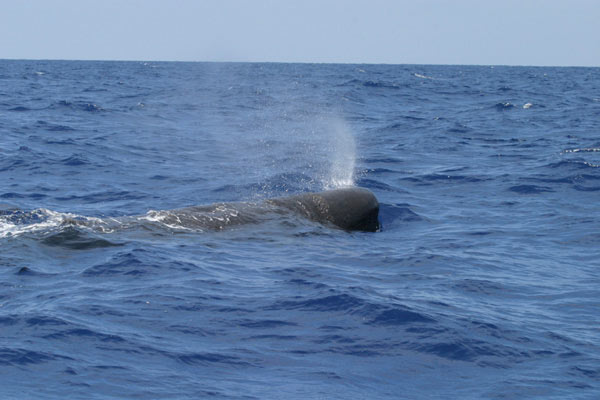Undersea Mics Listen for Gulf Whales Threatened by Oil Spill

Recently deployed electronic ears are eavesdropping on whales in the Gulf of Mexico, giving scientists insights into what areas they frequent, population numbers and how they are faring in the oil-ravaged waters.
"Night after night, on TV and on webcams, we saw oil spewing from the bottom of the ocean," said Christopher Clark, head of the Bioacoustics Research Program (BRP) team at the Cornell Lab of Ornithology. "You wonder, 'What can we do? What's the impact of this?' In the case of marine mammals, we don't know because we don't even know what's there."
The study will focus on sperm whales and Bryde's whales (a baleen whale that feeds on plankton), which the National Oceanic and Atmospheric Administration (NOAA) identified as species of concern in the Gulf as a result of the oil spill.
Eavesdropping on whales
To gauge whale health, the Cornell team (in partnership with NOAA) is placing the last of 22 so-called marine autonomous recording units in an arc along the continental shelf of the Gulf at depths of 2,296 to 3,280 feet (700 to 1,000 meters) in both spots affected by the oil and those not yet hit. The arc reflects the area where sperm whales feed.
Though not much is known about Bryde's whales' feeding spots, scientists do know the whale makes very low-frequency calls. And in the deep ocean those sounds travel far, suggesting the recorders will also pick up the Bryde's whale calls.
"Since whales use sounds as a communication, by listening we can tell what species are there, when they are there, and in some cases what are they doing," said Aaron Rice, BRP's science director.
Get the world’s most fascinating discoveries delivered straight to your inbox.
Humpbacks and right whales occasionally stray into the Gulf, but they aren't regulars, Rice said.
Counting whales
After three months of sound recording, a "burn wire" will get tripped, causing this anchor to burn and the units to float to the surface. (That's why the researchers affectionately call them "pop-ups.")
The data get turned into spectrograms, or graphs of frequency and time. "In most cases you can get an idea of relative abundance of whales and you can tell which whale" was making emitting the calls, Rice said, adding that one limitation is that when a bunch of whale calls get recorded it's tricky to tell if it's one whale making a lot of calls or several whales calling at once.
"But we can tell in many cases – is there one, more than one or a lot, which for assessing impact in the Gulf of Mexico is some of the most important information," Rice added.
The findings may not tell researchers exactly how the oil is affecting the whales, but they'll have clues.
They know the oil could directly serve as an irritant or worse, as it could also cause some sort of sickness or even fatality. Indirectly, the oil could kill their food (fish and plankton).
Strandings can also help clarify the reason behind potentially low population counts. "There's been one stranded sperm whale and a bunch of stranded sea turtles on beaches," along the Gulf during the oil spill disaster, Rice told LiveScience. "And they're not showing signs of oil toxicity – there's no evidence of oil residue in the tissues when they're necropsied." (A necropsy is an autopsy performed on an animal.)
However, fish and plankton in the area are showing "quite a bit of oil" in their tissues, Rice added.
- Gulf Oil Spill: Animals at Risk
- On the Brink: A Gallery of Wild Sharks
- Gallery: The World's Biggest Beasts
Jeanna Bryner is managing editor of Scientific American. Previously she was editor in chief of Live Science and, prior to that, an editor at Scholastic's Science World magazine. Bryner has an English degree from Salisbury University, a master's degree in biogeochemistry and environmental sciences from the University of Maryland and a graduate science journalism degree from New York University. She has worked as a biologist in Florida, where she monitored wetlands and did field surveys for endangered species, including the gorgeous Florida Scrub Jay. She also received an ocean sciences journalism fellowship from the Woods Hole Oceanographic Institution. She is a firm believer that science is for everyone and that just about everything can be viewed through the lens of science.
